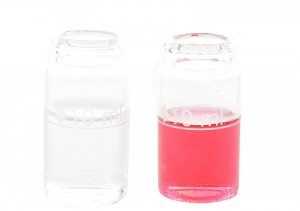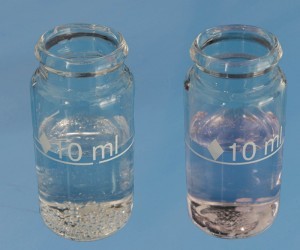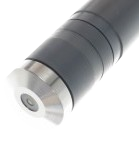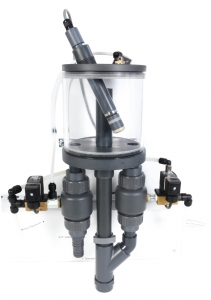You probably know that most chlorine, ozone and chlorine dioxide analyzers are calibrated using hand held DPD kits but…
… did you know that DPD can’t tell you when you have no residual?
… did you know that errors on DPD performance can be up to ± 100%?
… did you know that a significant number of service calls received by Pi relate to poor calibration?
DPD (N.N-diethyl-p-phenylenediamine) is a chemical that when mixed with water containing an oxidant, changes color depending on the concentration of the oxidant present. A handheld colorimeter measures light passing through the colored solution. The absorption of that light by the liquid gives a concentration value. It is usually used to check concentration of, for example, free chlorine, total chlorine, ozone and chlorine dioxide etc. in water.
 DPD vials containing water samples with oxidant (right) and without oxidant (left)
DPD vials containing water samples with oxidant (right) and without oxidant (left)When the DPD kit gives a value, it is often used to calibrate online instruments……and that is where Pi comes in!
As a manufacturer of online instruments we have to understand DPD in order to help our customers when they have problems calibrating their online monitors.
This Focus On will look at:
- The limitations of DPD (turbidity, zero oxidant, bleaching, pH and interferents).
- Minimizing DPD measurement error (sampling, alignment and cleaning).
- Things to look out for (low concentrations, pink color, stained glass).
- Little known chemistry (measuring bromine, chlorite versus chlorine dioxide).
- Rinse and repeat: is it really worth repeating my measurement?
What are the limitations of DPD?
DPD cannot measure zero oxidant well.
DPD works using the absorption of light, and turbidity in the sample will give a positive reading. This means if there is no oxidant in the sample, any turbidity introduced to the sample after ‘zero’ such as undissolved tablet or powder will cause the DPD test kit to give a small reading, this is why…
DPD cannot measure below approximately 0.05 ppm.
 DPD vials containing water samples with (right) and without (left) trace amount of oxidant
DPD vials containing water samples with (right) and without (left) trace amount of oxidantIf you suspect there is zero oxidant in your sample, hold the vial up to a white surface. If you cannot see any trace of pink color, it is likely any reading you are getting is from the unreacted DPD tablet.
DPD cannot measure free chlorine above 6 ppm
(and won’t always give a ‘high concentration’ reading error).
Many people are unaware that past a certain level of oxidant, DPD will not form its characteristic pink color, and instead will ‘bleach’ to form a clear solution. This can lead people to think there is little or no oxidant in their water, when in fact there is so much that it is bleaching their DPD. Be on the lookout for a flash of pink when the tablet or powder is added if you suspect your sample is being bleached. NB. special kits and reagents are available for measuring oxidant above 6 ppm.
DPD cannot measure in extremes of alkalinity or pH.
DPD tablets, powdered pillows, and drops contain buffers that will change the pH of your solution in order to facilitate DPD reacting with your oxidant. There is only so much buffering capability in the powder or tablet, and if your sample has an extreme of pH or alkalinity this could affect the concentration reading from the DPD handset.
DPD cannot distinguish between oxidants such as:
chlorine, chlorine dioxide, chlorite, ozone, organochlorides, bromine and more, meaning interferents are a big problem.
DPD is a fantastic chemical, in that it is very versatile as a coloring agent, which is how it gives the oxidant the color that we measure. This versatility does come at a price, DPD is not very specific as an analysis tool, and so if other chemicals are present in the sample, they can interfere with the reading, giving an inaccurate result. Common interferents include chlorine dioxide (for chlorine measurement, and vice versa), sodium chlorite, ozone, organochloramines, peroxides, and many more.
DPD cannot distinguish between color and turbidity.
Any undissolved solids, including unreacted DPD tablet, will affect the reading. Sample turbidity should be accounted for in the zero measurement. If the zero measurement has a high turbidity, this will affect the sensitivity of the colorimeter, due to the large correction it must perform to account for absorption by undissolved solids. Allowing any solids in the sample several seconds to settle after mixing is the best way to counteract this.
Minimizing DPD measurement error
Here is an easy to read, printable checklist to ensure accurate DPD readings every time.
Things to look out for
When was the last time your DPD was calibrated?
Like all measurement devices, handheld DPD colorimeters can drift over time, and need to be calibrated. Check your device manual for how often it should be calibrated, if you can’t remember the last time it was calibrated, chances are it needs doing again!
Stained Glass
 DPD vials with staining (left) and without staining (right)
DPD vials with staining (left) and without staining (right)The pink solution formed after DPD tests can leave a residue behind on the glass, which will affect the DPD reading. This residue can be easily cleaned off using what is in your DPD kit.
Tap water
If you use normal tap water to wash out vials, droplets left behind can affect your reading due to the residual chlorine in drinking water. It is best (but not always practical) to use deionized water to wash out your vials, but if this isn’t available (deionized water can be purchased as car battery top up water from any car parts supplier) then you can use cooled boiled tap water, as boiling gets rid of any chlorine. If not then simply make sure the vials are perfectly dry before use.
Little Known Chemistry
DPD has a wide range of interferents. This means recurrent problems can sometimes be caused by the chemical makeup of the sample. For example, chlorite (ClO2–) and chlorine dioxide both affect DPD, but only chlorine dioxide is measured by most chlorine dioxide amperometric sensors.
DPD can be used to track bromine, but DPD No.1 tablets measure FREE chlorine or TOTAL bromine. As combined bromine is just as effective a disinfectant as free bromine, this generally doesn’t pose too much of a problem, however some amperometric sensors measure free bromine, and cannot be calibrated using DPD No.1 tablets. For more information on measuring bromine, or chlorine in seawater, please see Pi’s technical note on Seawater Chlorination.
Rinse and repeat
How important is it to repeat my DPD measurement? Isn’t it a waste of time?
A sensor is only as good as its last calibration, and the sensor will be as accurate as you calibrate it to be. If you need your sensor for tight process control, such as a pool or dosing controller, then it is essential to repeat the DPD test at least twice, if not more. The reason it’s important to repeat the test is mainly due to human error, but variation in DPD tablets has been known, or it could be a slight concentration spike that you happened to pick up in your sample. With each repetition these circumstances become less and less likely, giving you more confidence in the value you use to calibrate your analyzer.
Pi recommends the following routine for calibration:
Perform a DPD test, and compare the reading to your analyzer.
- Is the reading within 10% of your analyzer? If yes, leave the analyzer alone.
- If the reading is not within 10%, repeat the DPD test.
- Is the second test within 10% of the first test? If yes, calibrate your instrument to this reading. If not, keep repeating the DPD tests until 2 consecutive tests are within 10%, then calibrate the machine to this reading.



 Chlorine Dioxide Analyzer in a Single Open Flow Cell
Chlorine Dioxide Analyzer in a Single Open Flow Cell
 DPD vials containing water samples with oxidant (right) and without oxidant (left)
DPD vials containing water samples with oxidant (right) and without oxidant (left) DPD vials containing water samples with (right) and without (left) trace amount of oxidant
DPD vials containing water samples with (right) and without (left) trace amount of oxidant DPD vials with staining (left) and without staining (right)
DPD vials with staining (left) and without staining (right)

